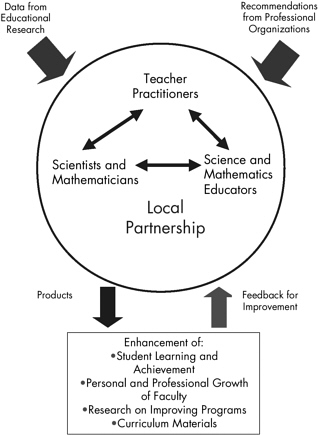The committee also holds that a critical pathway to achieving these changes will be the establishment of K-16 partnerships whose integrated programs and activities go well beyond those of most partnerships that exist today.
The committee envisions that all of the contributors and stakeholders in these partnerships would be recognized and utilized for their professional expertise in science, mathematics, and technology education. The partners would work collectively toward improving teaching and ongoing professional development for all teachers in the partnership community, including those in higher education. These partnerships collectively would establish and implement goals for improving the learning and academic achievements in science, mathematics, and technology of students in affiliated institutions, including students in teacher education programs and the children in the schools that are members of the partnerships.
It is particularly critical for institutions that engage in partnerships to reexamine their traditional roles in teacher education and the ways in which what they do are financially supported. For example, colleges and universities traditionally have been involved in oversight of education for prospective teachers. However, these institutions actually may be better suited to overseeing the ongoing professional development of practicing teachers. Similarly, school personnel may be better able to organize, oversee, and mentor the practicum and internship phases of teacher education.
In these examples, funding for the various phases of the continuum of teacher education would need to be restructured. Specifically, the CSMTP envisions partnerships that are funded primarily through multi-year, line-item commitments in the budgets of the participating institutions. While gifts and grants from external funders enhance programs and opportunities for teachers, they should not be the main source of support for collaborative partnerships for teacher education. Even for colleges and universities that rely on tuition as a major source of institutional income, the CSMTP holds that supporting these partnerships will yield both explicit and less tangible benefits. In addition to the improved education that declared teacher candidates would receive from this arrangement, institutional participation in a partnership could open windows of opportunity for many other students who might be considering teaching as a career option; engagement in partnership activities might help them make a favorable decision. In addition, the service to and goodwill from the local community that a private institution could engender through its support of a partnership could be invaluable in promoting community relations.
FIGURE 6-1 A model for K-16 partnerships involving the people and resources critical to effective teacher education in science and mathematics. In this partnership model, scientists and mathematicians, teacher educators for science and mathematics, and mentor teachers work as equally essential partners to enhance teacher education and to promote more effective learning and curricular materials for students who attend the schools within the partnership. The members of the partnership also work together to facilitate professional growth and development for each other. The partnership’s programs for teacher education ere informed by (1) educational research, (2) recommendations from national organizations involved with enhancing teaching, and (3) data gathered from the programs sponsored by the partnership itself.

Source: http://books.nap.edu/openbook.php?record_id=9832&page=91